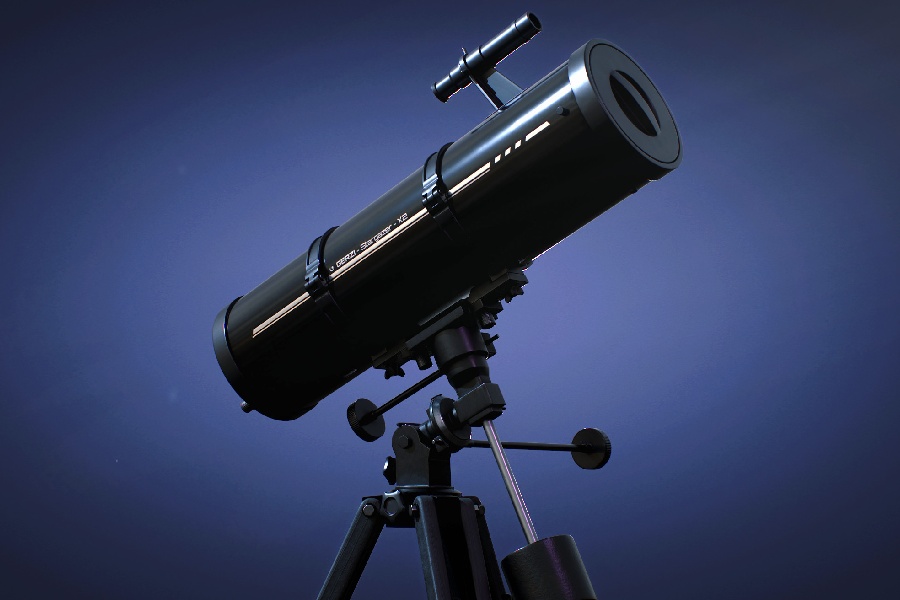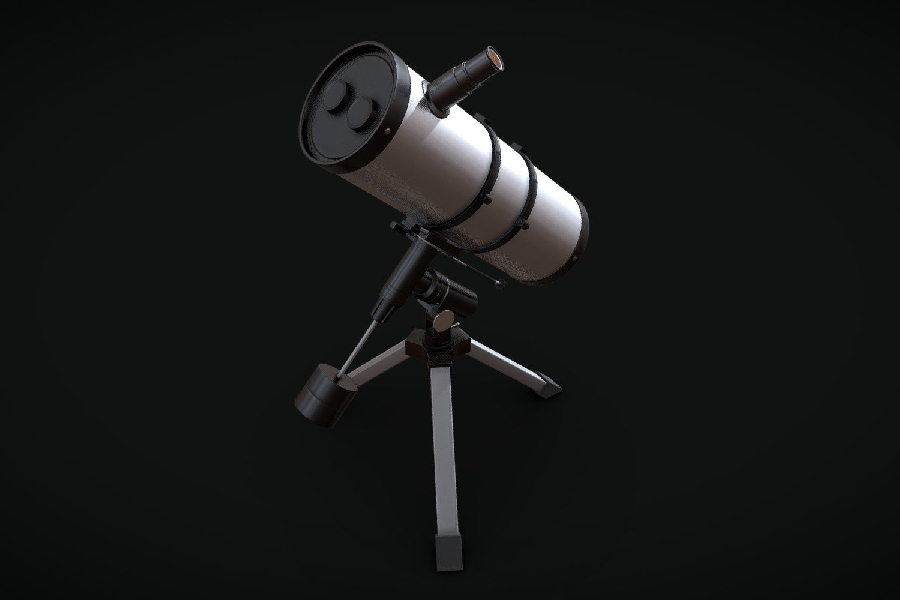Ever peered up at the star-dusted night sky, yearning to bridge the cosmic gap and touch the shimmering tapestry above? For ages, humans have sought ways to traverse this celestial divide. Enter telescopes – our dutiful tools in this quest to reach the heavens’ depths.
Yet, not every telescope serves this purpose equally. While some harness the light-bending power of glass lenses, others take a different tack. Known as reflecting telescopes, these ingenious devices leverage the magic of mirrored reflection to reveal the cosmos.
But what is a reflecting telescope, and what unique advantages empower its viewing prowess compared to its lens-based counterparts?
Join us as we tour the world of reflecting telescopes. We’ll explore their clever mirrored architecture, enabling them to uncover galactic marvels often inaccessible to other telescopes. And we’ll chart the history of key innovations and wondrous discoveries they’ve ushered in.

What Is a Reflecting Telescope?
What is a reflecting telescope? A reflecting telescope is an optical telescope that uses mirrors to gather and focus light. It employs a combination of curved mirrors to reflect and converge incoming light rays, creating an image.
The primary component is a concave mirror called the primary mirror, which reflects light to a focus point. This focal point can be observed directly or redirected to an eyepiece or camera for viewing or imaging.
Reflecting telescopes have advantages such as eliminating chromatic aberration, a common issue in refracting telescopes. They come in various designs, with the Newtonian, Cassegrain, and Dobsonian being popular configurations.
Reflecting telescopes are widely used in astronomy for their versatility and effectiveness in capturing celestial objects.
How Reflecting Telescopes Work?
Basic principles
Reflection of light
Imagine standing in a dark room with a flashlight. If you point it at a mirror, the light bounces off, illuminating something else in the room.
Reflecting telescopes work on the same principle but with cosmic rays instead of flashlights! The curved primary mirror captures light from distant objects and reflects it inwards.
Mirrors vs. lenses
Unlike lenses, which refract (bend) light differently depending on its color, mirrors reflect all colors equally. This eliminates chromatic aberration – a blurry rainbow effect seen in images from refracting telescopes.
Reflecting telescopes offer sharper, truer views of the universe, especially when observing faint or colorful objects.
Components of a reflecting telescope
Primary mirror
This is the heart of the telescope, a large, concave mirror polished to an incredibly smooth surface. Its shape, typically parabolic, precisely reflects incoming light to a single point called the focal point.
Secondary mirror
This smaller, flat mirror positioned strategically in the light path intercepts the focused beam from the primary mirror and redirects it towards the eyepiece or camera.
Imagine it as a celestial traffic cop, guiding the concentrated light to where it needs to go for us to see it.
Focal point
This magical spot is where the reflected light converges, forming a magnified image of the observed object. The eyepiece or camera is positioned precisely at this point to capture or magnify the image, revealing the secrets of the distant universe.
Evolution of Reflecting Telescopes
The journey of reflecting telescopes has been an extraordinary tale of human ingenuity and perseverance, fueled by a boundless desire to peer deeper into the cosmic unknown. Let’s explore the fascinating milestones that brought us to the awe-inspiring instruments of today.
Early reflecting telescopes
Contributions of inventors
The dawn of reflecting telescopes is inextricably linked to Isaac Newton, who in 1668, crafted the very first reflecting telescope in history. His ingenious design featured a curved “parabolic mirror” to gather light and a secondary mirror to redirect it to the eyepiece.
Technological challenges and breakthroughs
Early reflecting telescopes faced several challenges. Manufacturing large, flawless mirrors was difficult, and the reflective coatings of the time tarnished quickly. But the quest for cosmic knowledge spurred remarkable progress.
John Hadley developed improved polishing techniques in the 18th century, leading to larger and more precise mirrors.
Modern reflecting telescopes
Advanced designs
Today, reflecting telescopes exist in a breathtaking variety of configurations, each serving specific astronomical needs.
The Newtonian design, like Newton’s original, offers simplicity and versatility. Dobsonian telescopes prioritize accessibility and ease of use, making them popular among amateur astronomers.
Innovative technologies
Modern reflecting telescopes are marvels of cutting-edge technology. Astronomical mirrors are no longer made of metal but polished glass coated with aluminum or other reflective materials.
Active optics systems adjust the shape of the primary mirror in real time, compensating for distortions and ensuring the sharpest possible images.

Advantages of Reflecting Telescopes
Elimination of chromatic aberration – Sharper views from space
Imagine peering through a prism and seeing your favorite constellation distorted by a rainbow halo. That’s chromatic aberration, a nightmare for lens-based telescopes where different colors bend at different angles, blurring the image. Luckily, reflecting telescopes sidestep this drama!
Mirrors reflect equally
Mirrors don’t refract (bend) light; they simply bounce it off their surface. This means all colors, from fiery reds to deep blues, are reflected identically, resulting in crisper, sharper images where stars really twinkle and galaxies retain their true hues.
Enhanced planetary observations
Forget blurry planetary outlines! Reflecting telescopes reveal stunning details, from the swirling bands of Jupiter to the delicate rings of Saturn, thanks to their ability to deliver color-accurate views.
Large aperture possibilities – Embracing the gigantic
A bigger aperture means more light-gathering power, right? Reflecting telescopes take “big” to a whole new level. Unlike lenses, which become prohibitively heavy and expensive as they grow larger, mirrors offer a unique advantage.
Manufacturing made easy (ish)
Reflecting mirrors can be lighter and easier to build than large lenses, making it cost-effective to construct mega-mirrors capable of capturing vast amounts of light from faint, distant objects.
Giant leaps for astronomy
This size advantage has pushed the boundaries of astronomical observation. Giant reflecting telescopes like Keck in Hawaii and Hubble in space have unveiled countless cosmic wonders, from the formation of galaxies to the existence of exoplanets.
Cost-effectiveness – Democratizing the cosmos
While exploring the universe often conjures images of multi-million dollar telescopes, reflecting technology offers a surprisingly cost-effective option for both astronomers and amateur stargazers:
Simpler designs
Reflecting telescopes often have fewer components than their lens-based counterparts, making them cheaper to manufacture and maintain. This opens up celestial exploration to a wider range of individuals and institutions.
DIY delights
Some reflecting telescope designs, like Dobsonians, are renowned for their simplicity and affordability, making them popular choices for amateur astronomers who want to build their own piece of the sky.
Applications in Astronomy
Deep-space observations
Reflecting telescopes have enabled groundbreaking observations of deep space objects like galaxies, nebulae, and exoplanets located lightyears away. Their large light-collecting area is ideal for gathering faint light from distant celestial targets.
Discoveries enabled by reflecting telescopes
Many major astronomical discoveries were made possible by observations using reflecting telescopes. These include the detection of spiral nebulae, Halley’s Comet, the moons of Jupiter, the rings of Saturn, and other planets in our solar system.
Contribution to astrophotography
Reflecting telescopes are invaluable for astrophotography of galaxies, nebulae, star clusters, comets, and other astronomical phenomena. Their wide field of view and large aperture support stunning deep-space images.
Popular Reflecting Telescopes
Overview of notable models
Some well-known reflecting telescope models include the Hubble Space Telescope, Keck telescopes, Gran Telescopio Canarias, Giant Magellan Telescope, James Webb Space Telescope, and large amateur Dobsonian telescopes.
Key features and specifications
Notable reflecting telescopes boast impressive specs like 8-10 meter mirrors, adaptive optics, computer-controlled mounts, low expansion materials, open truss tubes, and high-tech instruments for imaging and spectroscopy.
User reviews and experiences
Amateur astronomers praise affordable Dobsonian reflectors for their large aperture, simple operation, and capability to observe deep sky objects not visible to the naked eye.
Professional reflectors like Hubble continue to generate incredible science results and breathtaking images.
Maintenance and Care Tips
Your reflecting telescope has opened a window to the wonders of the universe, but just like any prized instrument, it deserves proper care to keep it in peak condition. Let’s explore essential maintenance tips to ensure your cosmic companion delivers breathtaking views for years to come.
Cleaning reflecting telescope mirrors
- Before diving into deep cleaning, gently blow away loose dust particles with a compressed air blower or a camel hair brush. For stubborn dirt, prepare a lukewarm bath with distilled water and a few drops of dish soap.
- Never use tap water or harsh chemicals! Dip a clean, lint-free cotton ball in the soapy water and gently wipe the mirror surface in a circular motion.
- Rinse the cotton ball frequently and use fresh ones for each wipe.
- Rinse the mirror thoroughly with lukewarm distilled water, ensuring all soap residue is gone.
- Let the mirror air dry completely, or gently pat it dry with a clean, lint-free cloth. Never touch the mirror surface with your fingers!
Storage guidelines
- Protect your telescope from dust, moisture, and temperature fluctuations for optimal performance.
- Cover the telescope aperture with a dust cap when not in use.
- Store it in a clean, dry place, like a closet or dedicated telescope case. Avoid storing your telescope in damp environments, as moisture can damage the mirror coatings and electronics. Silica gel packets can help absorb excess moisture.
- Temperature extremes can disrupt the telescope’s delicate alignment. Avoid storing it in hot cars or freezing garages. Ideally, keep it in a room with a controlled temperature.
Troubleshooting common issues
Even the best-maintained telescopes can encounter glitches. Here’s how to tackle some common issues.
Check if the primary and secondary mirrors are aligned correctly. Consult your telescope manual for adjustment instructions.
These internal misalignments can also blur the image. Consider professional collimation if adjustments don’t improve clarity.
Conclusion
We hope this exploration has helped illustrate what is a reflecting telescope and the critical role this design has played in astronomy.
From Newton to Hubble, reflecting telescopes have enabled groundbreaking discoveries, stunning observations, and images of our universe. Their unique combination of large aperture, wide field of view, and light-gathering power has driven scientific breakthroughs and transformed our understanding of cosmology.
As technology continues advancing with new innovations, we look forward to many more years of discovery fueled by these amazing instruments. This article has shown how reflecting telescopes have served as invaluable tools for exploring the mysteries and beauty of the night sky.
